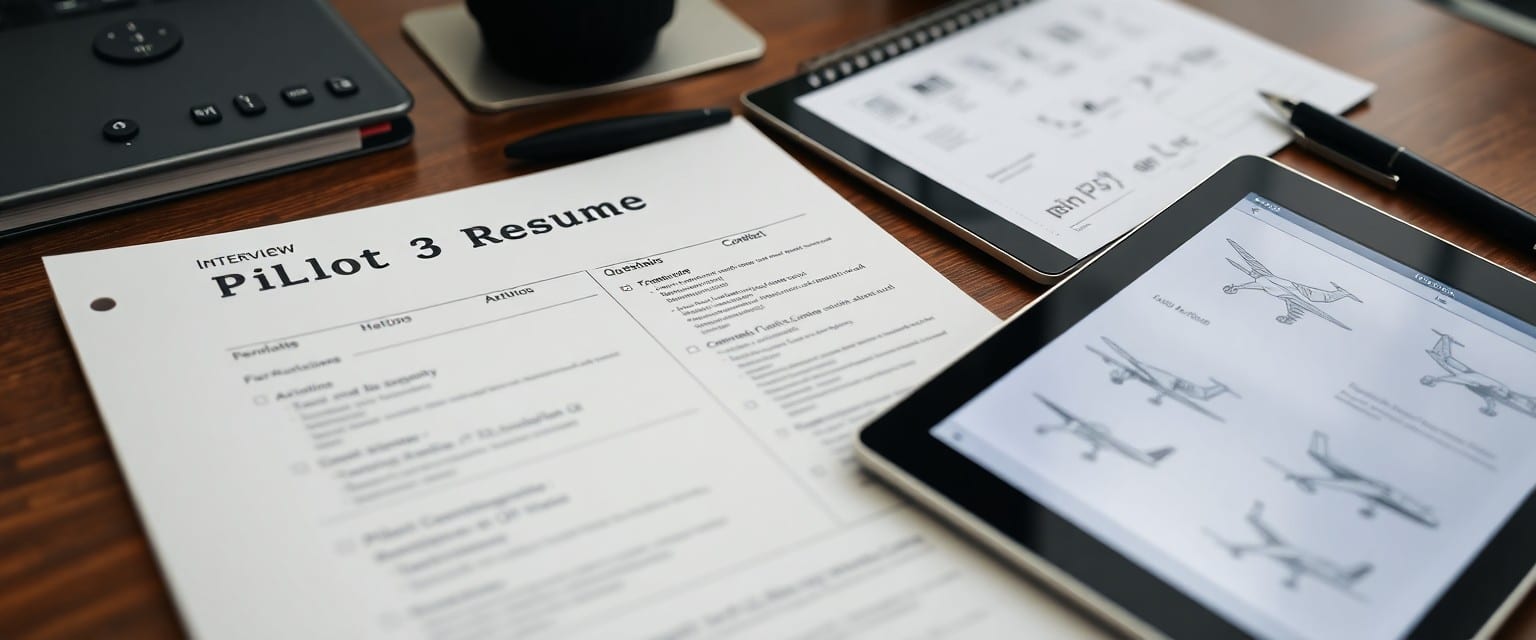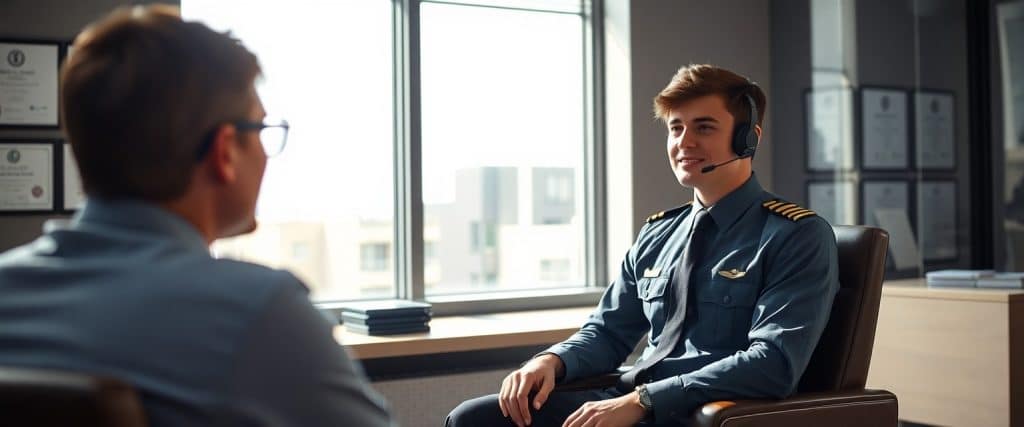Becoming an Airline Pilot
Top 10 Airline Pilot Interview Questions (and How to Answer Them)
Pilot interviews can be intense and highly competitive, requiring you to demonstrate not only your technical knowledge but also your decision-making and situational awareness. In this guide, you’ll discover the most common airline pilot interview questions along with expert strategies to answer them confidently and effectively. Understanding both the HR and technical components will help you stand out. By preparing with real examples and avoiding frequent pitfalls, you can maximize your chances of success in securing your dream aviation career.
Cracking the Code: The Top 10 Most Common Interview Questions for Pilots
The airline pilot interview commonly blends behavioral and technical inquiries, designed to assess your decision-making, teamwork, and aviation expertise under pressure. Expect questions about past challenges you’ve faced, how you prioritize safety, and detailed scenarios requiring you to demonstrate knowledge of aircraft systems or aviation regulations. Targeted preparation on these 10 frequently asked questions will sharpen your responses and boost your confidence, setting you apart in a highly competitive selection process.
Behavioral Questions: Showcasing Your Past Experiences
Behavioral questions focus on your past actions, revealing how you handle situations like emergency responses, conflict resolution, or leadership under stress. Questions such as “Describe a time you managed a difficult crew member” give you the chance to highlight teamwork, communication, and your commitment to safety culture. Use the STAR method (Situation, Task, Action, Result) to construct clear, concise stories that demonstrate your problem-solving skills and professionalism.
Technical Questions: Proving Your Aviation Knowledge
Technical questions examine your understanding of aircraft systems, meteorology, flight regulations, and aviation procedures. Interviewers might ask you to explain complex topics like engine failures, weight and balance calculations, or airspace classifications to verify your hands-on expertise. Your ability to explain these concepts clearly indicates not only knowledge but also readiness to apply that knowledge under operational pressures.

Crafting Compelling Responses: The STAR Method in Action
Answering airline pilot interview questions effectively often hinges on how clearly you present your experiences. The STAR method—Situation, Task, Action, Result—provides a structured approach that makes your responses concise yet detailed, demonstrating your problem-solving skills and professionalism. This technique not only organizes your thoughts but also highlights your decision-making process, critical in aviation roles where clarity and accountability matter. Using STAR helps you transform generic answers into compelling narratives that resonate with interviewers, increasing your chances to stand out.
Situation: Contextualizing Your Example
Set the stage by briefly describing the specific circumstance you faced. Choose situations relevant to flying or teamwork, such as managing unexpected weather or resolving cockpit communication issues. Detailing the environment and challenges shows your understanding of operational complexity and helps the interviewer visualize your decision-making context. For instance, “During a cross-country flight, turbulence significantly increased, affecting passenger comfort and flight stability.”
Task: Defining Your Role and Responsibility
Clarify what your specific responsibility was within the situation. Pinpointing your role highlights leadership and accountability, aspects highly valued by airlines. Instead of vague phrases like “I helped,” state your duties such as “As pilot flying, I was responsible for adjusting flight path and maintaining crew communication.” This distinction shows you took ownership under pressure.
Expanding on this, precisely describing your task helps differentiate you from others involved and signals your ability to manage critical duties independently. For example, explaining that you coordinated the crew response during a systems failure emphasizes decision-making under stress. Detail how your role required technical expertise and adherence to safety protocols to reassure interviewers of your competence in high-stakes environments.
Action: Highlighting What You Did
Focus on the concrete steps you took to address the task. Break down your problem-solving actions clearly, whether monitoring instruments, communicating with air traffic control, or leading the crew. Highlighting proactive measures and calm under pressure shows your operational readiness. For example, “I adjusted the autopilot settings, informed ATC of turbulence, and coordinated cabin crew to secure the cabin.”
Providing more depth, describe the reasoning behind your decisions, such as choosing specific maneuvers or communication protocols. This demonstrates your technical knowledge and situational awareness, which are critical to safe flight operations. Explaining how you prioritized tasks under time constraints also showcases your ability to maintain focus and efficiency in complex scenarios.
Result: Sharing Outcomes and Lessons Learned
Summarize the positive outcomes stemming from your actions, using measurable or observable results where possible. Mentioning a safe landing, improved crew coordination, or passenger reassurance validates your effective response. Include insights gained, like enhanced risk assessment skills, which reflects a commitment to continuous improvement.
Elaborating further, discuss how the incident influenced your approach to future flights and training. Showing how you translated experience into professional growth aligns with airlines’ emphasis on adaptability and learning. For example, detailing how you implemented improved pre-flight briefings after the event indicates forward-thinking that benefits both safety and teamwork.
The Art of Preparation: Essential Strategies for Aspiring Pilots
Mastering airline pilot interviews demands more than technical knowledge; preparation must encompass understanding airline values, refining communication skills, and anticipating behavioral scenarios. Developing a structured study plan focusing on both HR and technical questions fuels confidence and sharpens your responses. Leveraging resources like company reports, pilot forums, and official training manuals enables targeted preparation. Incorporating time management techniques ensures you balance knowledge review and mock practice effectively, allowing you to enter the interview with clarity and poise.
Researching the Airline: Tailoring Your Approach
Diving deep into the airline’s culture, fleet composition, and recent news presents you as an informed candidate aligned with their mission. For instance, if an airline emphasizes sustainability, highlighting your interest or experience in eco-friendly flying practices can set you apart. Reviewing their route networks and growth strategies allows you to frame answers in ways that resonate with their business direction. This tailored approach reflects genuine enthusiasm and strategic thinking, qualities airline recruiters highly value.
Mock Interviews: The Value of Practice
Simulated interviews replicate the real interview’s pace and pressure, enabling you to refine delivery and identify gaps in knowledge. Practicing with peers or mentors familiar with pilot assessments helps incorporate constructive feedback. Recording mock sessions and reviewing body language enhances non-verbal communication skills. Frequent exposure to typical questions builds fluency, turning hesitant responses into confident dialogue ready for HR and technical panels alike.
Expanding on mock interviews, integrating scenario-based drills sharpens decision-making under stress, a core element at airlines like Delta or Emirates. Using platforms that provide airline-specific question banks lets you rehearse realistic questions such as managing in-flight emergencies or crew resource management conflicts. Additionally, setting timers during mock sessions trains you to provide concise yet comprehensive answers, a skill airlines consistently seek to evaluate during the limited interview time. This deliberate practice bridges the gap between textbook knowledge and practical application, dramatically increasing your odds of success.
Navigating the Pitfalls: Common Mistakes to Avoid During Interviews
Focusing too heavily on your technical prowess can unintentionally downplay equally vital attributes, such as teamwork, adaptability, and communication skills. Airline recruiters seek well-rounded candidates who excel not just in flying but also in managing real-world scenarios under pressure. Neglecting the balance between hard skills and personal fit often leads to missed opportunities, as interviewers look for pilots who align with their safety culture and company values. Demonstrating situational awareness and interpersonal strengths alongside your technical knowledge substantially improves your chances of making a lasting, positive impression.
Overemphasizing Technical Skill at the Expense of Personal Fit
Pouring all your energy into detailing aircraft systems or flight procedures without highlighting how you integrate into a crew environment risks appearing one-dimensional. Airlines value candidates who show emotional intelligence, leadership under stress, and effective communication. For instance, recounting a time you resolved a cockpit dispute diplomatically or supported a nervous co-pilot reflects team compatibility beyond textbook knowledge. Balancing technical expertise with stories showcasing interpersonal skills presents you as a pilot ready for complex, people-driven situations.
Failing to Prepare for Behavioral and Situational Questions
Lean interviews often draw heavily on behavioral questions designed to assess your decision-making, conflict resolution, and stress management. Approaching these questions without tailored examples can leave responses vague or superficial, signaling a lack of readiness. You should practice the STAR (Situation, Task, Action, Result) method to deliver concise, vivid answers that highlight your real-life application of soft skills. Many who’ve stumbled here missed opportunities to differentiate themselves through engaging, structured storytelling.
Diving deeper into behavioral and situational preparation reveals that airlines prioritize how you handle unforeseen challenges, not just routine technical checks. Examples such as defusing a passenger conflict mid-flight, adjusting rapidly to sudden weather changes, or collaborating with ATC during emergencies demonstrate competence under pressure and decision-making clarity. Preparing a bank of specific scenarios from your flight experience maximizes confidence and ensures your stories directly address common pilot interview themes. Well-prepared candidates often outperform technically superior but less communicative peers in these key areas.
Beyond the Basics: Questions You Should Ask the Interviewers
Engaging interviewers with thoughtful questions about their airline demonstrates your genuine interest and insight into the role. Asking targeted questions helps you gather vital information that shows you’re evaluating the fit as much as they are. Focus on areas like company ethos, training pathways, or career progression to set yourself apart and signal professionalism beyond just answering questions.
Inquire About Company Culture and Values
Delve into how the airline supports teamwork, safety priorities, and pilot well-being by asking about the company’s culture and core values. For instance, inquire if they emphasize continuous learning or how leadership fosters open communication. Their responses reveal how aligned you’d be with their operational environment and what daily life looks like—not just the job description.
Understanding Advancement Opportunities and Training Programs
Ask specifics about career development tracks and training curricula to reveal transparency and commitment to pilot growth. Find out how often upgrades happen, what type of type-rating courses they offer, and whether mentorship programs exist. Airlines like Delta or Emirates often provide structured pathways with clear timelines, which can help you visualize your future progression within the company.

Conclusion
Presently, mastering the top 10 airline pilot interview questions and how to answer them can significantly enhance your chances of success. By preparing thoughtfully for both HR and technical components, you demonstrate competence and professionalism that airlines seek. Use structured responses, stay calm under pressure, and leverage provided strategies to set yourself apart. Accessing additional resources like downloadable guides ensures you enter your interview well-equipped and confident. Your thorough preparation today lays the foundation for a promising career in aviation.
Frequently Asked Questions About Airline Pilot Interviews
What are the most common airline pilot interview questions?
Common airline pilot interview questions include: “Tell me about yourself,” “Why do you want to work for this airline?”, “Describe a time you handled an emergency,” and “What are your strengths and weaknesses as a pilot?”
How should I prepare for a technical pilot interview?
Review your aircraft systems, performance charts, SOPs, and refresh knowledge on meteorology, navigation, and CRM principles. Practice simulator scenarios if part of the assessment.
How long does the airline pilot interview process take?
It can take from a few hours to a full day, often including HR interviews, technical assessments, simulator evaluations, and sometimes psychological profiling.
What should I wear to an airline pilot interview?
A clean, well-fitting pilot uniform or a conservative business suit. Appearance and professionalism are essential for a strong first impression.
Do airlines care more about technical skill or personality?
Both matter. Airlines look for technically competent pilots who also demonstrate teamwork, calm under pressure, and strong communication—qualities vital for CRM and safety.

